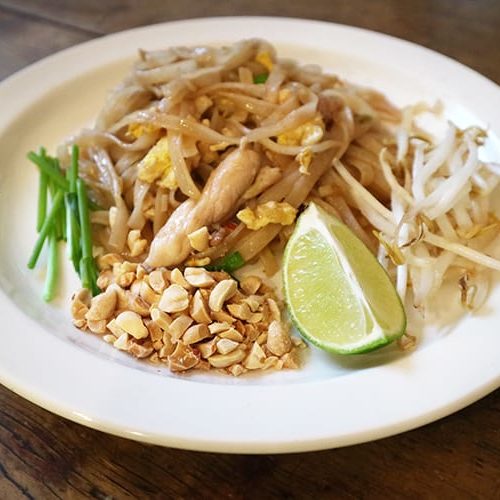Chicken Pad Thai
An authentic Pad Thai recipe from Thailand which can be tailored to be vegetarian or peanut free!
Equipment
- Wok
- Food Scale
Ingredients
Pad Thai Noodles
- 60 ml Canola Oil
- 40 g Firm Tofu (diced in 1 cm cubes)
- 10 g Shallot (minced)
- 4 Cloves Garlic (minced)
- 100 g Boneless Chicken Thigh Meat (sliced into small strips)
- 2 Eggs
- 200 g Fresh or Rehydrated Dried Rice Noodles
- 20 g Bean Sprouts
- 4 Scallions (cut into 2 inch pieces)
- 20 g Pickled Radish (optional)
- ½ tsp Red Shrimp Paste (optional)
Pad Thai Sauce
- 0-1 tsp Red Chili Flakes (based on taste)
- 2 tbsp Oyster Sauce
- 1 tbsp Fish Sauce
- 2 tbsp Tamarind Paste
- 3 tsp Palm Sugar
- 120 ml Chicken Stock
Garnish
- ¼ cup Crushed Peanuts (optional)
- Red Pepper Flakes (optional)
- Scallions
- Bean Sprouts
- Lime
Instructions
Prep
- Prep everything above prior to starting. Thai food cooks quickly so there won't be time to do it once you start.
- Combine the Pad Thai sauce ingredients into a bowl and mix them together. Decide how much chili you want to add based on your preference. In Thailand, they use 1 tsp for this recipe. I cried when I ate it. Now, I choose to use 1 dried chili which I remove the seeds from. You do not have to use any chili if you don’t want.
- If you cannot find fresh Pad Thai noodles, then you can rehydrate them by soaking them in warm water for 25 minutes prior to starting. Make sure to strain the water out before you begin to cook.
- Put everything in bowls next to the stove. When you begin to cook, things will move quickly, and it’s good to have it near you.
Cooking Instructions
- In a wok (or sauté pan) add the vegetable oil over medium-high heat. Once it’s hot and shimmering, add the tofu and fry it until it’s a little crispy.
- Once the tofu is crispy, add the minced shallots and garlic. Fry it until it is fragrant while being careful not to burn the garlic.
- Once fragrant, add the chicken and stir until it’s fully cooked.
- If you are great at using a wok, you can push everything to one side so it is off of the heat. When you add the new ingredients, they should not be combined with the old ones. If you aren’t a pro with a wok, I recommend having a spare bowl next to your work station. You can put what you’ve cooked into the bowl and add it back in later.
- Crack the eggs into the bottom of the wok and scramble lightly. Once cooked, use your spoon to break it into smaller pieces. Once the pieces are a little crispy on the edges, push the egg to the side of the pan with the chicken and tofu (or into your separate bowl).
- Pour the Pad Thai sauce into the bottom of the wok. The sauce will begin to boil in a few seconds. Continue to keep the already cooked items separate.
- Once the sauce begins to boil, add the rehydrated rice noodles. Stir them in the sauce quickly and add the pickled radish (optional) and shrimp paste (optional).
- Stir until the noodles are translucent and cooked.
- Once cooked, add the already cooked ingredients that were set to the side and stir them in for 1 minute.
- Turn off the heat, and toss in the bean sprouts and scallions. Continue stirring for a few seconds.
- Serve your Pad Thai on a plate. You can add peanuts for garnish if you like, but it’s not necessary. You can also add some fresh scallions, bean sprouts, red chili, a slice of lime, and raw sugar.
Notes
Vegetarian Variation
- Substitute chicken stock with water and chicken with extra tofu
- If you add more chicken, you’ll need to compensate with more Pad Thai sauce.
- Doubling or tripling this recipe is difficult as the items need space to cook in the wok. It’s better to do a few small batches then to attempt one large batch.
